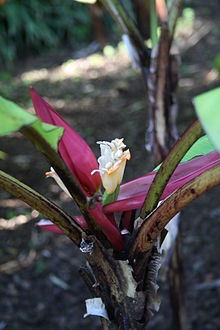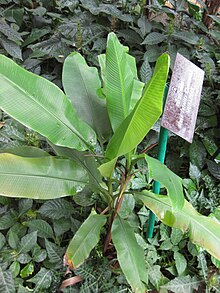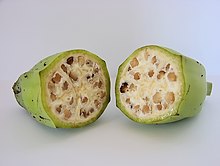Bananas
| Bananas | ||||||||||||
|---|---|---|---|---|---|---|---|---|---|---|---|---|

Dessert banana ( Musa × paradisiaca ) ' Cavendish ' |
||||||||||||
| Systematics | ||||||||||||
|
||||||||||||
| Scientific name | ||||||||||||
| Musa | ||||||||||||
| L. |
The bananas ( Musa ), obsolete figs of paradise , are a genus of plants in the banana family (Musaceae) within the monocotyledons . The approximately 70 species come - with one species in Tanzania - all from tropical to subtropical Asia and the western Pacific region .
Some species and hybrids produce edible fruits, of which those of the dessert banana ( Musa × paradisiaca ) are grown for food production.
description
Appearance and leaves
Musa species and varieties are evergreen, perennial , herbaceous plants . They have a rhizome underground from which runners drift. The actual shoot axis remains very short until the flowering period. The "trunk" is a non-woody pseudo trunk consisting of the massive leaf stalks or leaf sheaths with a real trunk in the middle . It is at least half a meter, but usually three to ten meters high. It can be somewhat thickened at the base. The large, simple, whole-margined leaves are rolled in the bud position : As with the sister group of the Strelitziaceae , the leaves show convolute vernation (rolled bud position). They are clearly divided into petiole and leaf blade . The leaf blade is oblong or oblong-elliptical in shape, it reaches a length of two to three meters with a width of 30 to 60 centimeters. Older leaves are often torn several times up to the midrib.
Inflorescences and flowers
The terminal inflorescence usually hangs over, but sometimes it is also upright. It is mostly covered with numerous green, brown or red-violet spathe-shaped bracts , which gradually fall off. On the underside of each bract there are several flowers in one or two rows. At the base of the inflorescence, the flowers surrounded by a bract are female (with stunted stamens ), towards the end of the inflorescence there are quickly fading, tubular male flowers with five stamens in the so-called "banana heart" (bell), a large, hanging colored bud . The male flowers are arranged in rows in the layers (bud) formed by several bracts, with a whitish core (the heart) in the middle of the bud. Five of the six colored, serrated, lobed bracts of the flowers have grown together to form a tube that rips open on one side to the base. The three-chamber ovary is subordinate. Hermaphrodite flowers can stand between the female and male flowers. The structurally threefold flowers are often pollinated by bats ( chiropterophilia ).
Infructescence, fruits and seeds
The fruit cluster of bananas is called a "tuft". A "tuft" can consist of 6 to 19 so-called "hands", which encompass the individual rows of a tuft. The individual fruits, which botanically belong to the berries , are usually 20 to 35 centimeters long and also referred to as "fingers". They are elongated, mostly curved, slightly angular in cross section. The curvature is due to negative gravitropism . Each “hand” of a “tuft” contains around 10 to 20 “fingers”.
In wild forms, many seeds are formed in the berry after fertilization. With parthenocarpic forms of culture no seeds develop. The seeds are irregularly spherical to lenticular.
Most species are monocarp , so they die after they have fructified. As a rule, however, kindles have formed on the root tuber , so that the plant is persistent.
Sets of chromosomes
Depending on the section, the basic chromosome number is x = 10 or 11. In the wild forms, diploidy is usually present. Cultivated forms have other degrees of ploidy , for example triploidy.
Pests
The black sigatoka fungus spreads on the leaves of the dessert banana , which is why industrially operated banana plantations are sprayed with fungicides once a week .

use
food
The pulp of many varieties of Musa × paradisiaca and other hybrids is edible. Today the cultivated bananas bring it together to over 1000 crosses and varieties.
Compared to other types of fruit, conventional planted bananas contain a comparatively high amount of fructose and thus a lot of carbohydrates and also a lot of calories. Nevertheless, next to apples, bananas are the Germans' most popular fruit. A survey from 2015 says that the average person in Germany consumes around 12 kilograms of bananas per year. Despite the high proportion of the simple sugar fructose ( monosaccharide ), it is still undisputed in nutritional science that the hybrids of Musa x paradisica are healthy. The high proportion of calcium , antioxidants and vitamins promotes muscle functions, inhibits sources of inflammation and regulates metabolic processes. Worldwide, bananas provide a large part of the basal metabolic rate of calories and vitamins, especially in emerging countries.
In addition to the mealy-sweet dessert bananas also are plantains an important food source . Their whitish-yellow pulp, which has a mild to slightly sour taste, is not suitable for raw consumption . It is both boiled and baked or grilled. Banana blossoms (also known as "banana hearts") are also used as a fruit in Southeast Asian cuisine, while banana leaves often serve as a kind of serving tray or flavor-enhancing baking and grill shell.
The "banana heart" is also edible, both the fleshy, whitish core (the heart) as well as the bracts and the flowers.
textiles
From the fiber bananas ( Musa textilis ), called abacá , which are widespread in Indonesia , the so-called manila fibers of the leaf sheaths are processed into nets , cordage and yarn .

Ornamental plants
Some types of bananas are used as ornamental plants, especially in tropical and subtropical countries. These include varieties that are propagated via seeds as well as those that are propagated vegetatively using offshoots. The most common ornamental plant is Musa ornata , this was planted in European ornamental gardens before it was scientifically described. While ornamental bananas grow and bloom all year round in tropical climates, in subtropical and warm (Mediterranean) climates they enter a dormancy phase in winter. There are moderately frost-hardy varieties that overwinter in the ground without any special protection and sprout again the following year. A well-known "hardy" type of banana is the Japanese fiber banana ( Musa basjoo ); Several varieties with improved frost resistance have been bred from it.
Diseases and varieties
At the beginning of the 20th century, cultivation regions were affected by Panama disease . The fungus Fusarium oxysporum f. sp. cubense , strain TR1 (= tropical race 1), which persists in the soil for years, penetrated the roots. Around 1960, the Gros Michel variety was widely switched to the more resistant Cavendish . A new variant of the mushroom - TR4 - was discovered in several sub-variants in Southeast Asia in the 1990s and also spread to Africa and the Middle East. The mushroom is now found almost worldwide, in all major growing areas, including Malaysia, Indonesia, Thailand, India, China and the Philippines, and thus in the largest growing areas worldwide. Variants also occur in subtropical growing areas. Efforts are now being made to replace the Cavendish monocultures with new varieties in order to make the massive spread of a disease more difficult in the future. None of the previously registered varieties should be considered for this.
At the KU Leuven there is a gene database with currently over 1530 banana varieties. This ensures that these different varieties are preserved for future generations.
etymology
The word banana came into German through the Portuguese banana . It originally comes from a West African language, probably from the Wolof . The banana got its scientific name when the botanist Carl von Linné classified the flora of the world in 1753. He named the banana using the Arabic-Persian nameموز / mauz for the fruit Musa paradisiaca (for the plantain ) or Musa sapientium (for the dessert banana ) → Musa Cliffortiana .
Systematics
The genus Musa was established in 1753 by Carl von Linné in Species Plantarum , 2, p. 1043. Musa paradisiaca L. was specified as the lectotype species by Michel Adanson in Familles des plantes , 1st edition, volume 2, pp. 525, 580 in 1763 .
Sections and types
The division of the genus Musa into sections has changed repeatedly. According to Wong et al. In 2002 the genus Musa is divided into the three sections Musa , Callimusa and Ingentimusa ; they put the species of the Rhodochlamys section in the Musa section and those of the Australimusa section in Callimusa . Markku Häkkinen also exhibited Ingentimusa in Callimusa in 2013 ; thus there are only two sections that differ, for example, in the basic chromosome number x = 11 and x = 10.
Since then, the genus Musa has only been divided into the two sections Musa and Callimusa and contains around 83 species and some subspecies or varieties.
| Musa section |
|---|
| The species from the Rhodochlamys section, which was previously considered separately, are also placed in this section . |
| The basic chromosome number is x = 11. |
| It contains about 34 species (here with their distribution areas): |

Inflorescence of Musa mannii

Inflorescence of Musa ornata

Habitus and leaves of Musa rubra
|
| Callimusa section |
|---|
| The basic chromosome number is x = 10. |
| The species of the Australimusa and Ingentimusa sections, which were previously considered separately, are also placed in this section . |
| It contains about 37 species (here with their distribution areas): |

Inflorescence of Musa coccinea

Habit and leaves of Musa gracilis
|
| Without assignment to a section (13 types): |
|---|
|
Hybrids
There are some hybrids , for example:
- Musa × alinsanaya R.V. Valmayor, a hybrid ofMusa acuminatasubsp. banksii×M. textilisin thePhilippines.
- Musa × paradisiaca L. , dessert banana : Probably created by crossing Musa acuminata and Musa balbisiana . It is likely to be the most widely grown species in the world. It is native to Malaysia and the Philippines.
literature
- Delin Wu & W. John Kress: Musaceae . In: Wu Zhengyi, Peter H. Raven (Ed.): Flora of China . Flagellariaceae through Marantaceae. Volume 24. Science Press and Missouri Botanical Garden Press, Beijing and St. Louis 2000, ISBN 0-915279-83-5 , Musa , pp. 315 ( online - printed work with same text online).
- Alan T. Whittemore: Musaceae . In: Flora of North America Editorial Committee (Ed.): Flora of North America North of Mexico . Magnoliophyta: Alismatidae, Arecidae, Commelinidae (in part), and Zingiberidae. Volume 22. Oxford University Press, New York and Oxford 2000, ISBN 0-19-513729-9 , Musa ( online - printed work with the same text online).
- Carol Wong, R. Kiew, G. Argent, O. Set, SK Lee & YY Gan: Assessment of the validity of the sections in Musa (Musaceae) using AFLP , In: Annals of Botany , Volume 90, Issue 2, 2002, Pp. 231-238.
- Ai-Zhong Liu, W. John Kress & De-Zhu Li: Phylogenetic analyzes of the banana family (Musaceae) based on nuclear ribosomal (ITS) and chloroplast (trnL-F) evidence , In: Taxon , Volume 59, Issue 1, 2010, pp. 20–28.
- Pavla Christelová, Miroslav Valárik, Eva Hřibová, Edmond De Langhe & Jaroslav Doležel: A multi gene sequence-based phylogeny of the Musaceae (banana) family , In: BMC Evolutionary Biology , 2011. doi: 10.1186 / 1471-2148-11-103
- SC Nelson, RC Ploetz & AK Kepler: Musa species (banana and plantain) , In: Species Profiles for Pacific Island Agroforestry - www.traditionaltree.org , 2006: Full text PDF.
- Markku Häkkinen: Reappraisal of sectional taxonomy in Musa (Musaceae) , In: Taxon , Volume 62, Issue 4, 2013, pp. 809-813.
- Anne Vézina: Musa sections at ProMusa . Last update of the website August 29, 2013
Movie
- Cheap. Cheaper. Banana. A food item is being sold. Documentary, Germany, 2013, 29 Min, written and directed by. Sarah Zierul, Production: WDR , Row: day 7 , first broadcast on 3 June 2013 in ARD , Summary with video-neck and film images ( Memento of 30 June 2013 in Internet Archive ) from WDR.
- Ranga Yogeshwar : Crooked thing - What the banana tells us about the world , WDR Quarks & Co from January 5, 2016
Web links
- Michel H. Porcher, 2011: Sorting Musa names at Multilingual Multiscripted Plant Name Database = MMPND.
- 7 facts about bananas
Individual evidence
- ↑ a b c d e f g h i j k l m n o p q r s t u v w x y z aa ab ac ad ae af ag ah ai aj ak al am an ao ap aq ar as at au av aw ax ay az ba bb bc bd be bf bg bh bi bj bk bl bm bn bo bp bq br bs bt bu bv bw bx by bz ca cb cc cd ce cf cg ch ci cj ck cl Rafaël Govaerts (Ed.): Musa. In: World Checklist of Selected Plant Families (WCSP) - The Board of Trustees of the Royal Botanic Gardens, Kew . Retrieved August 10, 2018.
- ↑ a b c d Delin Wu & W. John Kress: Musaceae . In: Wu Zhengyi, Peter H. Raven (Ed.): Flora of China . Flagellariaceae through Marantaceae. Volume 24. Science Press and Missouri Botanical Garden Press, Beijing and St. Louis 2000, ISBN 0-915279-83-5 , Musa , pp. 315 ( online - printed work with same text online).
- ↑ a b c d Alan T. Whittemore: Musaceae . In: Flora of North America Editorial Committee (Ed.): Flora of North America North of Mexico . Magnoliophyta: Alismatidae, Arecidae, Commelinidae (in part), and Zingiberidae. Volume 22. Oxford University Press, New York and Oxford 2000, ISBN 0-19-513729-9 , Musa ( online - printed work with the same text online).
- ↑ Morphology of the banana plant on promusa.org, accessed May 16, 2018.
- ↑ Bananas. FAO, 1977, 1984, 1992, ISBN 92-5-100149-9 , online .
- ^ Banana Project at The University of Queensland, Australia, accessed May 16, 2018.
- ↑ banana. (No longer available online.) In: exotenfrucht.de. Archived from the original on July 17, 2013 ; Retrieved January 23, 2013 .
- ↑ Useful plants database - Musa × paradisiaca L. (No longer available online.) Philipps University of Marburg , archived from the original on February 2, 2014 ; accessed on February 1, 2014 .
- ↑ picture of "Black sigatoka" ( Memento of 30 June 2013 Internet Archive ) in: daserste.de , June 30, 2013
- ↑ Sprühflugzeug ( Memento from June 30, 2013 in the Internet Archive ) in: daserste.de , June 30, 2013
- ^ Atlant Bieri: Banana Republic of Switzerland. ( Memento from October 15, 2010 in the Internet Archive ) In: NZZ am Sonntag , January 6, 2008, p. 60
- ↑ Per capita consumption of bananas in Germany until 2015/16 | Statistics. Retrieved February 26, 2019 .
- ↑ Esendugue Fonsah, Richard Wallace, Gerard Krewer (2008): Why Are There Seeds In My Banana? A Look at Ornamental Bananas. Journal of Food Distribution Research 39 (1) PDF download
- ↑ Musa ornata - Flowering Banana. Hawaiian Plants and Tropical Flowers, by T. Beth Kinsey.
- ↑ Alfred Joe, Mamiyil Sabu (2016): Wild ornamental Bananas in India: an overview. South Indian Journal Of Biological Sciences 2 (1): 213-221.
- ↑ Musa basjoo - care, propagation and wintering. In: gartendialog.de , accessed on June 28, 2014
- ↑ A fungus threatens the supermarket banana kleinezeitung.at, January 3, 2016, accessed on January 3, 2016.
- ↑ Leuven - the banana metropolis diplomatie.belgium.be, January 20, 2017.
- ↑ Gene bank for bananas: Plantation in the test tube spiegel.de, August 30, 2017.
- ↑ First publication scanned at biodiversitylibrary.org .
- ^ Musa at Tropicos.org. Missouri Botanical Garden, St. Louis, accessed May 5, 2013.
- ↑ Musa in the Germplasm Resources Information Network (GRIN), USDA , ARS , National Genetic Resources Program. National Germplasm Resources Laboratory, Beltsville, Maryland. Retrieved May 5, 2013.
- ↑ Markku Hakkinen: Epitypification of some Musa sect. Callimusa Cheesman and Musa L. sect. Musa names from Vietnam (Musaceae) , In: NeBIO , Volume 4, No. 4, August 2013, pp. 7–8. ISSN 2278-2281 full text PDF.
- ^ Anne Vézina: Musa sections at ProMusa . Last update of the website August 29, 2013
- ^ A b Alfred Joe, PE Sreejith & M. Sabu: Notes on the Rediscovery and Taxonomic Status of M. flaviflora NWSimmonds and M. thomsonii (King ex Schumann) AMCowan & Cowan (Musaceae) From India. In: Annals of Plant Sciences, Volume 2, Issue 8, 2013. pp. 260-267 , archived from the original on April 4, 2014 ; accessed on January 15, 2015 .
- ↑ Musa nanensis: New Species of Wild Banana Discovered in Thailand. In: Sci-News. October 18, 2015.
- ↑ The Biology of Musa L. (banana). Version 2: October 2016 (PDF; 1.5 MB), from Office of the Gene Technology Regulator, accessed on May 16, 2018.
- ↑ M. Häkkinen, M. Suleiman & J. Gisil: Acta Phytotaxonomica et Geobotanica . Volume 56, Issue 2, 2005, pp. 135-140.
- ↑ M. Häkkinen & H. Väre: Typification and check-list of Musa L. names (Musaceae) with nomenclatural notes . In: Adansonia , III, 30, 2008, pp. 63-112
- ↑ Musa fitzalanii - Daintree's River Banana. In: Species Profile and Threats Database. Australian Government - Department of the Environment, accessed January 15, 2015 .









